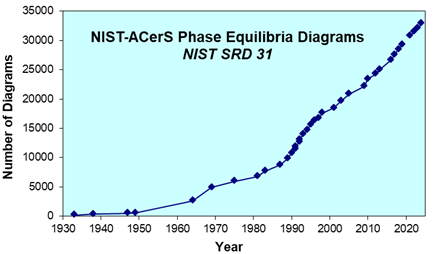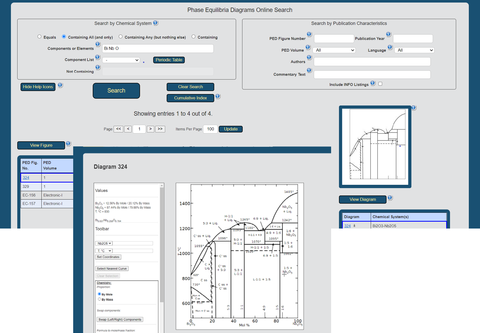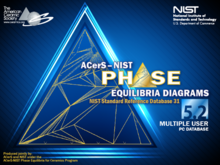Summary
Compile and evaluate phase equilibrium data for NIST Standard Reference Database 31 (Phase Equilibria Diagrams); disseminate the data in a readily accessible and searchable format in partnership with the American Ceramic Society

Description
Every deliberate effort to develop a new material or to improve processing begins with chemical composition and the conditions (temperature, pressure) under which pure compounds and their mixtures are stable (an equilibrium phase diagram). In the absence of such information, materials scientists must resort to trial-and-error approaches or conduct studies themselves to obtain the data. For commercially important materials, phase equilibrium diagrams provide critical starting information to devise processing schemes that facilitate quality-assurance efforts and optimize the properties needed for specific applications. For the exploration and design of new materials, including computational studies, the diagrams provide fundamental information on the occurrence and chemical composition of existing compounds as well as their thermodynamic properties.
This critically evaluated database provides 33,000 maps of the equilibrium chemical and structural behaviors exhibited by a wide range of non‐organic material‐types including: Oxides and mixed systems with oxides; chalcogenides (sulfides, selenides, tellurides); pnictides (N, P, As, Sb, Bi); actinides (U, Pu, Th) and actinide‐surrogates (Ce); oxy‐cation systems (e.g. molybdates, vanadates); semiconductors (Si, Ge, Sn); group-3 systems (B, Al, Ga, In, Tl); and salts, including mixed systems with salts. The data are pertinent for materials used across a broad spectrum of technologies in applications such as optoelectronics, thermal‐barrier coatings, sensors, energy converters, nuclear‐waste reprocessing, nuclear‐reactor technology, photovoltaics, pigments, fuel cells, catalysts, thermoelectrics, capacitors, transducers, thermoluminescents, molten‐salt batteries, photovoltaics, electrolytic refining, and semiconductor manufacturing.
Background
Published from 1964 to 1992 as the reference-series Phase Diagrams for Ceramists ("Blue Books"), SRD 31 is the result of a long-standing collaboration between NIST and The American Ceramic Society to develop and maintain a state-of-the-art database of evaluated phase equilibria data for industrial and academic customers. NIST (then NBS) staff played key roles in establishing the project as a data-driven extension of existing core expertise in phase equilibrium science, thermodynamics, crystallography, and diffraction methods for the identification and characterization of crystalline materials. In 1992 the title was changed to the more general Phase Equilibria Diagrams to emphasize that the data are useful to the broader inorganic materials community. Since 2005 the database has been disseminated only electronically; each updated version is a comprehensive collection of all content previously published in any format, plus new content consisting of 600-800 new phase diagrams annually.

SRD 31 is produced by the NIST Data Center using a custom, web-based Content Management System (CMS) running under Ubuntu Linux using the Ruby programming language. The system uses an Nginx web-server, SQLite database, the Route scheduling system, and an object relational mapper for the GUI. Commentary data is entered using the LaTeX document preparation system; phase diagrams are entered as interactive digital files after digitization using custom software developed by NIST staff. The data-center process begins with bimonthly searches of the most recently published literature using a systematic set of keywords. Papers with new diagrams deemed suitable for the collection are then sent to scientists with expertise in phase-equilibria science – and foreign-language translation as necessary – who write critical summaries of each study and diagram according to guidelines provided by NIST; the American Ceramic Society assists in recruiting these subject-matter experts via their print media. New diagrams are digitized at NIST, paired with the commentary text, and entered in the database as new Figures, which are reviewed and edited in multiple passes by NIST editors prior to final publication. Each step of this process is entered, tracked, and completed within the CMS.
Customers
Annual sales of SRD 31 total are on the order of $200 K. The user community includes more than 400 customers in industrial, academic, and government laboratories located in the U.S. and 31 countries.
Availability


NIST SRD 31 can be purchased as a stand-alone PC product (at NIST Standard Reference Database 31) or as an online subscription-based version (at www.ceramics.org). Both products use the same browser-based search interface, which includes expandable detailed help icons at each user‐input location. Phase diagrams can be viewed and manipulated interactively; capabilities include zoom, rotate, curve-follow, mol/wt % cursor-readout, lever rule, and overlay. The diagram display-window includes a Help file detailing each function. Users can perform keyword-searches of the critical evaluations of all PED Figures, allowing them to associate material systems with any potential applications mentioned in the evaluation. All PED Figures can be viewed or printed as complete .pdf files (commentary plus diagrams) which are similar in quality to those in the previously published books.
NIST staff and Associates with computers having NIST IP addresses (Gaithersburg and Boulder) can access SRD31 online free of charge at https://phaseonline.ceramics.org/ped_figure_search.
A Demonstration Version of SRD 31 can be downloaded at NIST Standard Reference Database 31 and provides several useful features at no cost. This version allows the user to experience the complete functionality of the product, including all functions of the diagram-display software, but with limited content. Also included is a comprehensive Cumulative Index for the entire database, which can be searched and sorted by chemical system to reveal what materials are covered in all 32,000 diagrams.
In addition, the Help menu provides a downloadable .pdf file of the classic tutorial General Discussion of Phase Diagrams, by F.P. Hall et al. (containing a glossary of phase-equilibrium terminology and thermodynamic definitions), background information for using the database (sections Common Tasks, FAQ, Chemical System Designation Rules), and a detailed history of this project and its publications.
The PED Editor, custom software developed by NIST staff, is also available for free download at NIST Standard Reference Database 31. This program can be used to digitize phase diagrams or to extract data from phase diagrams or other two‐dimensional scientific drawings. The PED Editor is a Java program which uses the iText open‐source PDF file generation library, Batik open‐source SVG file generation library, Jackson open‐source JSON file generation library, and the JAMA Java Matrix package.
Related Publications
Phase Equilibria Diagrams, NIST Standard Reference Database 31, v.5.2, NIST and The American Ceramic Society, Westerville, OH, ©2024.
Crystal chemistry and phase equilibria of the CaO-½Ho2O3-CoOz system at 885 °C in air, W. Wong-Ng , W. Laws, Q. Huang, J. Hou, S.H. Lapidus, L. Ribaud, J.A. Kaduk; Solid State Sciences 107 (2020) 106348 https://doi.org/10.1016/j.solidstatesciences.2020.106348
Crystal chemistry and phase equilibria of the CaO-½Dy2O3-CoOz system at 885 °C in air, W. Wong-Ng, W. Laws, J.A. Kaduk, Solid State Sciences 88 (2019) 57–62 https://doi.org/10.1016/j.solidstatesciences.2018.12.010
Phase equilibria and crystal chemistry of the CaO-½Gd2O3-CoOz system at 885 °C in air, W. Wong-Ng a, *, W. Laws a, S.H. Lapidus b, L. Ribaud b, J.A. Kaduk; Solid State Sciences 72 (2017) 47-54 https://doi.org/10.1016/j.solidstatesciences.2017.08.005
Crystal chemistry and phase equilibria of the CaO-½Eu2O3-CoOz system at 885 °C, W. Wong-Ng, W. Laws, J.A. Kaduk, Solid State Sciences 58 (2016) 105-110 https://doi.org/10.1016/j.solidstatesciences.2016.06.007
Experimental Determination of Phase Equilibria Diagrams in Ceramic Systems, R.S. Roth and T.A. Vanderah, in Solid State Ionics, The Science And Technology Of Ions In Motion, pp. 3-18, edited by B.V.R. Chowdari et al., World Scientific Publishing Co., 2004. https://doi.org/10.1142/9789812702586_0001
Major Accomplishments

Version 5 of Standard Reference Database 31 introduces a custom JavaScript viewer for interactive display of the diagrams – the SRD31 software is now a self-contained application, no longer requiring the installation and use of Java. As confirmed by customer feedback since the initial release in 2022, the new viewer simplifies and significantly enhances the user experience while preserving all previously available analytical capabilities.
The third release in this new series, Version 5.2, is now available to the public. This version provides the Vol 26 content-update, 171 new Figures with 767 new diagrams, including the first diagrams for more than 200 new systems. The new content in this version continues to reflect the explosion of research on the fundamental properties of materials needed to enable the transition to green-energy technologies and manufacturing, including the sustainable processing of raw materials and recycling/recovery of critical metals from secondary sources or low-grade ores. New chemical systems and diagrams in v.5.2 provide data needed to advance a wide variety of applications including hydrogen-production by electrolysis of water, thermal-energy storage and heat-transfer media for concentrated solar power (CSP), advanced molten-salt nuclear reactors (complex salt systems for fuel; thorium fuel-cycle; corrosion), lead-free photovoltaics with high conversion efficiencies, optical information-processing, batteries, semiconductors (processing; materials for next-generation electronics and solar cells), lasers for optoelectronics, ultra-lightweight structural materials for aerospace applications, and advanced dental porcelain.

